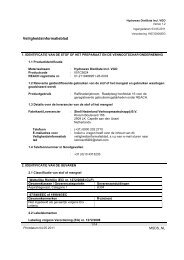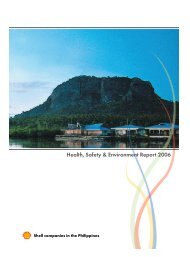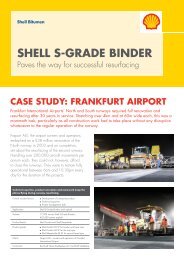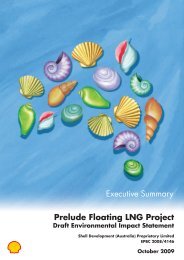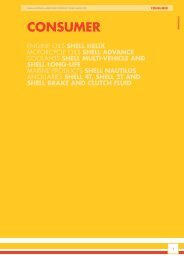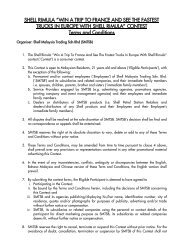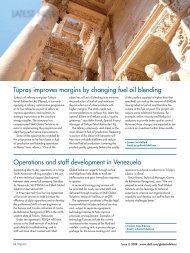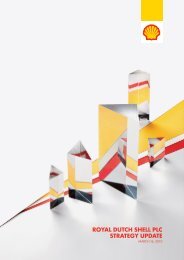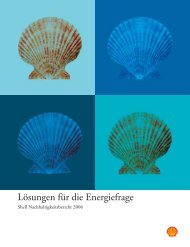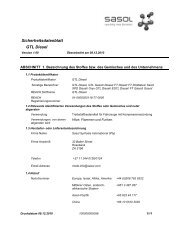Technical limit thinking produces steep learning curve - Shell
Technical limit thinking produces steep learning curve - Shell
Technical limit thinking produces steep learning curve - Shell
You also want an ePaper? Increase the reach of your titles
YUMPU automatically turns print PDFs into web optimized ePapers that Google loves.
<strong>Technical</strong> <strong>limit</strong> <strong>thinking</strong> <strong>produces</strong><br />
<strong>steep</strong> <strong>learning</strong> <strong>curve</strong><br />
Daysto drill a well went from almost 100to below 60 daysin Saih Rawl.<br />
OlutayoAjimoko,Petroleum Development Oman*<br />
<strong>Technical</strong> <strong>limit</strong> <strong>thinking</strong> is a conceptual feedback tool for<br />
maximizing drilling efficiency.It involvesfirst determining the<br />
conditions and engineering practicesthat willlead to the minimum<br />
time and/or cost at which a given well can be drilled,<br />
and then employing motivational and training techniques to<br />
implement those practices. <strong>Shell</strong> and Petroleum Development<br />
Oman (PDO) produced a highly developed technical <strong>limit</strong><br />
program for the challenging Saih Rawl gas field, which culminated<br />
in the landmark drilling of the field'sfirst sub-60-day<br />
well, Saih Raw1228, in 57.89 days, against an AFE time of75<br />
days. <strong>Shell</strong> and PDO leveraged the methodology to further<br />
teamwork, knowledge management and bit optimization to<br />
progressivelyreduce well construction time.<br />
BACKGROUND<br />
Saih Rawl is an onshore deep gas field in southern Oman<br />
and the biggest gas field in the country. It is split into three<br />
geographically and tectonically separated blocks: SR Main to<br />
the north, SR Graben and SR South, Fig. 1.<br />
The field is a large, elongated northeast-southwest-oriented<br />
anticline, with the anticlinal axisdipping to the southwest. A<br />
system of northwest-southeast-trending faults delineates and<br />
sealsthe structure's northern boundary. The varying compartmentalization<br />
of the fault system accounts for the high anisotropy,<br />
and thus for the extreme drilling challengesencountered<br />
in the different lithological packages.<br />
A typical well design in the Saih Rawl field starts with a<br />
I7Y2-in. hole from surface to the Naith limestone at about<br />
950 m (3,100 ft) to set 133h-in.casing.This is followed by a<br />
I2IA-in. section to about 3,200 m (10,500 ft), where the 9%in.<br />
casing is set in the AI KhlatalHasira formation. Thereafter,<br />
a 2,050-m (6,730-ft), 83h-in.section is drilled to section TO<br />
in the Amin formation. The I7Y2-in.section and I2IA-in.section<br />
are drilled on rotary.<br />
At the beginning of field exploration in 1991 and of exploration<br />
on surrounding wells, the 83h-in. section was initially<br />
drilled with roller-cone bits on rotary assemblies.In the intervening<br />
time, roller-cone bits have been gradually replaced by<br />
diamond-impregnated bits, so that by 2005, the entire 83h-in.<br />
section from drillout to TO was drilled almost exclusivelywith<br />
turbine drive systemsand diamond-impregnated bits.<br />
TECHNICAL LIMIT WELL<br />
The technical <strong>limit</strong> is defined as a measure of perfect performance<br />
<strong>limit</strong>ed only by technology availableand/or by the<br />
'Since writing this article, Mr. Ajimoko has changed employment. He now<br />
works for BP.<br />
DRILLING TECHNOLOGY<br />
laws of physics. In well drilling, this performance measure is<br />
the minimum possible time and/or cost to drill a typical well<br />
in a given field. In Saih Rawl, lessonslearned in previouswells<br />
helped the team to identify the optimization practices that<br />
would lead to a technical-<strong>limit</strong> well, Fig. 2. Among these:<br />
· A Le Fleur circulation packer could be used, and downtime<br />
could be minimized to reduce the flat spot berween the<br />
I7Y2-and 12IA-in.sections.<br />
· A higher-capacity centrifuge could optimize hydraulics<br />
to speed up the 8%-in. section. · A wireline formation tester could be run to eliminate<br />
three logging trips and a wiper trip.<br />
In addition, the technical <strong>limit</strong> well would maximize trip<br />
efficiencies,optimize hole cleaningand mud conditioning and<br />
increasebit life.The team determined the Saih Rawl technical<br />
<strong>limit</strong> well time to be 32.7 days.<br />
Removingtechnological<strong>limit</strong>ations from the equation yields<br />
the "perfectwell time," a theoretical construct that can be useful<br />
for defining drilling targets. The perfect well time is the<br />
minimum time in which a well could be drilled <strong>limit</strong>ed only<br />
by the physics of the drilling practice, calculated from clearly<br />
definedphysicalfactorsthat constrain the drilling time: the rock<br />
strength, operational <strong>limit</strong>s, number of casingstrings,hole size,<br />
etc.The perfectwell time in Saih Rawlis 18.4 days,Fig.3.<br />
WELL CONSTRUCTION<br />
Historically, about 70% of the total well construction time<br />
in Saih Rawl, as in most deep gas wells, is spent drilling ahead<br />
and tripping. The bit penetration rate and bit life, therefore,<br />
both have a major impact on well construction time and cost.<br />
Hypothetically, if both penetration rate and bit life could be<br />
doubled, an average 30% total reduction in drilling time and<br />
cost would result.<br />
A dynamic drilling optimization process has evolved for drilling<br />
the Saih Rawl field. The drilling program employed on Saih<br />
Rawl 228 involved drilling the I7Y2-in. tophole section with a<br />
roller-cone bit to a TVD of959 m (3,150 ft) in the Naith-A formation<br />
and casing off with I33h-in. casing. The casing was set<br />
about 15 m (49 ft) into the Naith-A limestone to minimize the<br />
exposure time of the Shargi shales and to reduce casing costs.<br />
Next, rwo PDC bits on rotary drilled the I2IA-in. surface-hole<br />
section to a TVD of 3,049 m (10,000 ft) in the AI Khlata sandstone,<br />
and it was cased off with a 9%-in. casing. It was critical in<br />
this hole section to case off the potentially hydrocarbon-bearing<br />
Shuaiba and Mafraq formations above the AI Khlata, and to isolate<br />
the troublesome and time-dependent Gharif shales.<br />
The 83h-in. section was drilled to a TVD of5,287 m (17,350<br />
ft) in the Amin formation with four diamond-impregnated bits<br />
World Oil JULY 2007 103
DRILLING TECHNOLOGY<br />
....... I. . . . .<br />
'~ ...~.... ....... ;.:.:.:.<br />
......... .......<br />
:I:.:';,-.:.:.: I . .~. . .<br />
:.:-:':.:.:.:':<br />
...,.... .. ....... ,.11I......<br />
.' '.".... , ~ ...118....<br />
I<br />
Formation<br />
FiqaArada<br />
FiqaShargi<br />
NaithAIB<br />
!NaithE.<br />
.NahrUmr<br />
Shuaiba<br />
Kharab<br />
Lekhwair<br />
Habshan<br />
Tuwaiq<br />
Dhruma<br />
Mafraq<br />
Sudair<br />
KhuffU<br />
KhuffM<br />
KhuffL<br />
GharifU<br />
1>fiarifM<br />
GharifL<br />
AIKhlata<br />
Baseincise<br />
valley<br />
188<br />
230<br />
974<br />
1;'237<br />
1,391<br />
1,481<br />
1,546<br />
1,585<br />
1,808<br />
1,933<br />
1,973<br />
2,110<br />
2,182<br />
2,237<br />
2,693<br />
2,879<br />
2,988<br />
3,061<br />
3,110<br />
3,207<br />
SahNihayadal 3,424<br />
Ghudun I 3,564<br />
Barakat<br />
Mabrouk<br />
455<br />
762<br />
2,351<br />
4,370<br />
4,442<br />
4587<br />
4:j94<br />
4800<br />
.5'010<br />
-<br />
5,348<br />
"'5;166-<br />
5.363<br />
:10<br />
:10<br />
:10<br />
:10<br />
:10<br />
:10<br />
:10 I Possible<br />
:10 losses<br />
:10<br />
:10<br />
:10<br />
:10 Possible<br />
:10<br />
:10 I<br />
:10<br />
losses<br />
Possible<br />
losses<br />
:10<br />
:10 Water<br />
:1:1If<br />
:10 1<br />
:10<br />
Water<br />
Water<br />
:10<br />
:10<br />
:10<br />
:10<br />
:10<br />
Gas/cond.<br />
Gas/water<br />
Water<br />
Gas-<br />
-mis<br />
Water<br />
Fig. 1. A stratigraphic column showing the formation tops<br />
associated with the Saih Rawl gas field.<br />
on turbine. The 83/s-in.section servedasboth the intermediate<br />
and production sections.A tapered completion string of 4\12<br />
x 5 x 5Y2-in. chrome tubular was then run and cemented in<br />
place.The chrome tubular was selectedto mitigate corrosion.<br />
The 83/s-in.section presentsthe greatestchallenge to successfully<br />
drilling useableholes in Saih Raw!, becausethe rock<br />
strength is very high, with unconfined compressivestrength<br />
sometimes on the order of 60,000 psi. In addition, local lithological<br />
variation, compounded by diverse anisotropies, makes<br />
drilling optimization difficult. It follows that this is the most<br />
104 JULY2007WorldOil<br />
E 1,000<br />
.c<br />
c.<br />
CD<br />
"C<br />
~3,000<br />
5,000<br />
SaihRawltechinical<strong>limit</strong><br />
well time=32.7days<br />
Rig days<br />
ITI1)Wheeledloads;2) Nightmoves;3) Sparemudtanksandauxiliaryequipt;<br />
4) Incentivesfor movers.<br />
~ 1)OriIl1~-in. sectionin36hours;2)Optimizeholecleaningandhydraulics.<br />
[[] 1)Minimizedowntime,reduceflatspot;2) EmployLeFleurCirculationpacker.<br />
@]1)OriIl12'4-in.sectionin4 dayswith 1 POCbit,includingwipertrip;<br />
2)Optimizehydraulics;3) UsemodifiedOBM.<br />
[[] 1)Increasetrip efficiency;2)Improveholeandmudconditioning.<br />
[I] 1)Orill83/s-in.sectionin 2 bit runswI infinitelydurableimpregnatedbits.<br />
2) InstallcentrifugewI highercapacityto optimizehydraulics.<br />
II] 1)Runpressuretesterandeliminate3 loggingtrips pluswipertrip.<br />
Fig.2. The drilled depth is plotted againsttime for the<br />
technical <strong>limit</strong> well, along with practices that would be used to<br />
achieve the <strong>limit</strong>.<br />
'"<br />
Theperfectwell<br />
(18.4days)<br />
to<br />
C<br />
'"<br />
Ec<br />
'5i<strong>Technical</strong><strong>limit</strong><br />
Q..well(32.7days)<br />
Basecase<br />
well(60.7days)<br />
-----------.<br />
ILaserdrilling(6)I<br />
IIntelligentandautomatedrigsystem(F)I<br />
Liquidcasing/drillingwithcasing(E)I<br />
IIntelligentrockandfluid evaluationlogs(0)I<br />
~<br />
IMaximumvaluedrilling(C)I<br />
I Minimumcostdrilling(B)I<br />
~<br />
IOptimizedrig moves,offlinemaximization(All<br />
Experience<br />
Fig. 3. The performance <strong>curve</strong> of the perfect well is shown.<br />
crucial hole section, accounting for about half of total well<br />
construction time. Moreover, it penetrates the Miqrat and<br />
Barik objective reservoirs.Drilling the section with diamondimpregnated<br />
bits is a lesson learned following several uneconomic<br />
and failed attempts to drill the section with PDC bits<br />
on rotary and with motors.<br />
CRITICAL SUCCESS FACTORS<br />
Approaching the technical <strong>limit</strong> requires optimizing all the<br />
factors that enter into the drilling operation. Optimizing the<br />
staff includes both increasing their productivity and encouraging<br />
and using crew members' ideas for optimizing other<br />
factors, such as knowledge management and drillbit performance.<br />
<strong>Shell</strong> and PDO used these strategies in Saih Rawl to<br />
cut well time by over 40%.<br />
Teamwork. The foundations of any successful team effort<br />
are open, free communication and a shared goal.The rig team<br />
is put on an incentive program at the beginning of the contract,<br />
and the performance incentive goal bonds the rig team<br />
together. The rig team consists of the drilling contractor, the<br />
service vendors and the drilling optimization engineer. The
DRILLING TECHNOLOGY<br />
160<br />
140<br />
120<br />
100<br />
en<br />
~ 80<br />
60<br />
40<br />
20<br />
o<br />
...............<br />
Saih Saih<br />
Rawl Rawl<br />
197 204<br />
Saih Saih Saih<br />
Rawl Rawl Rawl<br />
208 215 221<br />
I<br />
Saih Saih<br />
Rawl Rawl<br />
225 228<br />
Fig. 4. Lessons learned while drilling the Saih Rawl204<br />
well helped operators progressively reduce drilling time to<br />
ultimately achieve a sub-50-day well.<br />
cohesiveness established early in the campaign has sustained<br />
the continuous performance improvement of the rig. The initial<br />
motivation for performance was the reward incentive, but<br />
this was largely superseded by the operational excellence principles<br />
and technical <strong>limit</strong> philosophies that the drilling office<br />
team incorporated into the modus operandi. The following<br />
key points are worth mentioning:<br />
· Continuity. The rig has maintained most of the crew<br />
members who began the contract in 2003. As a result, rig efficiency<br />
and effectiveness have been excellent.<br />
· Competition. Desire to outperform other rigs in the<br />
field forged a stronger bond between the rig team and the office<br />
team, perhaps overriding the team incentive alone.<br />
· Communication. Goals were clearly communicated and<br />
understood across the team.<br />
· Operational Excellence. OE is a process-oriented enterprise<br />
program that drives improvements in the way a work<br />
group or corporation delivers products and services to its customers.<br />
Operational excellence calls for more than subject<br />
matter expertise and a talented internal team.<br />
The OE philosophy in PD~'s Exploration and Gas department<br />
aims to incorporate the following principles:<br />
Ideas from field staff drive success. The Saih Rawl well<br />
engineering and rig team members are motivated to improve<br />
operations. Team members are respected and their suggestions<br />
are encouraged. A constant feedback and feed-forward cycle<br />
ensures continual improvement.<br />
Analysis paralysis breeds crisis. Rather than focusing on<br />
analyzing potential problems or improvement opportunities,<br />
which may allow them to become much more troublesome<br />
and costly, team members are empowered to make decisions<br />
and solve problems at the lowest possible level. This has minimized<br />
operational failures while drilling in Saih Rawl. Every<br />
team member is empowered to stop work not only for safety,<br />
but also to increase operational excellence.<br />
Ideas need champions. Leadership in the department<br />
aims to encourage originators of ideas to champion them by<br />
spearheading the efforts to develop and implement them.<br />
Team leaders also sometimes discretionally select champions<br />
to serve as focal points, enabling an all-inclusive performance<br />
improvement environment.<br />
Knowledge management. The Saih Rawl experience illustrates<br />
that the time value of knowledge supersedes the time<br />
value of money, especially when drilling for deep gas. The primary<br />
objective of the team's knowledge management strategy<br />
106 JULY 2007 World Oil<br />
--......- - -<br />
-<br />
- -<br />
- -<br />
Fig. 5. The 12V4-in.Hycalog DSX290A2 PDC drillbit.<br />
wasto drill each hole section correctlythe first time. Recycling<br />
of knowledgeand lessonslearned were de-emphasized in favor<br />
of reinforcingpracticesworth replicating or best practices, and<br />
this expedited decision making.<br />
Total Quality Well Delivery(TQWD) was achievedin Saih<br />
Rawl field by adequately managing lessons learned from past<br />
wells and applying them to subsequent wells, Fig. 4. Team<br />
motivation was emphasized over complex logic to achieve<br />
TQWD.<br />
Benchmarking also played an important role. Historically,<br />
three KCA Deutag rigs operated in the field since 2003, and<br />
they all drilled the same well types. Therefore, data exchange,<br />
information sharing and benchmark practices worth replicating<br />
were easilyestablished,and most of the unpleasant lessons<br />
did not have to be learned twice.<br />
Staff continuity also contributed to maintaining a useful<br />
knowledge base. Staffmembers moving up or moving on had<br />
replacements waiting within the crew and being mentored.<br />
This practice and long tenures (at least 2 yr) of the incumbents<br />
have facilitated a downward trend of the performance <strong>learning</strong><br />
<strong>curve</strong>. Extensive lessons were learned on Saih Rawl 204,<br />
which took more than 130 days to drill. The well was especiallyproblematic<br />
due to the difficult directional work carried<br />
out, and the lessonslearned were passed on.<br />
Knowledge management in the Saih Rawl field has had to<br />
be dynamic since 2003, becauseat any point in time there are<br />
at least three rigs drilling different hole sections or performing<br />
different phases of well construction. The drilling team<br />
was given the rare opportunity of simultaneously <strong>learning</strong>before-doing,<br />
<strong>learning</strong>-while-doing and <strong>learning</strong>-aFter-doing.<br />
The end result is the progressivedownward trend in <strong>learning</strong><br />
<strong>curve</strong> time.<br />
Bit optimization. The biggestfactor to reduce wellconstruction<br />
cost and time is drilling useable boreholes more quickly.<br />
Bit optimization is a continuously evolving process in Saih<br />
Rawl field. Drilling optimization engineers, supplied by the<br />
vendors who worked in the PD~ officeas part of the rig team,<br />
have sped up bit technological advancement and optimized<br />
the bit-application process.
Fig. 6. The 83fa-in.Smith K507BCTPXX diamond-impregnated<br />
bit.<br />
To date, the biggest improvement has been recorded in the<br />
121,4-in. section with innovative developments in POC bit<br />
technology. The typical formations penetrated in the 121,4-in.<br />
section include shale, sandstone, limestone, clays, dolomites<br />
and sometimes streaks and beds of pyrite, the latter having been<br />
penetrated in the dolomitic limestone of the Khuff formation.<br />
To improve drilling efficiency and meet the challenges<br />
posed by the formation vagaries, the bit design has undergone<br />
several iterations and revisions in cutter size, number of<br />
blades, diamond hardness and bit proflle. The POC bit durability,<br />
stability and aggressiveness also have undergone several<br />
tunings and re-tuning.<br />
The Hycalog OSX290 drillbit has proven to be a game<br />
changer, as the bit has helped reduce construction time in the<br />
121,4-in. section by an average of 41 %, Fig. 5. The bit has a<br />
parr-ring design that ensures total lateral stability and a proprietary<br />
"steering wheel" to ensure good borehole quality.<br />
Notable progress has also been recorded in the 83h-in. section<br />
typically drilled with a diamond-impregnated bit on a<br />
turbine drive. The hole section is very tough due to the uncompromising<br />
mix of lithologies, and reliability is the prime<br />
objective. The Smith K507BCTPXX has proven to be the<br />
most reliable bit from the stock on offer; the choice was<br />
reached after several wells, Fig. 6.<br />
There are two scenarios for performance opportunity in<br />
this section. The first is improving the durability of diamondimpregnated<br />
bits and making them stay in the hole longer.<br />
This strategy gives a longer section interval but at a slower<br />
drilling rate. The second scenario is sacrificing the durability<br />
to achieve faster ROP. The downside to this strategy is that it<br />
will require more bits to drill the section. So far, the second<br />
scenario has given the best result and is the preferred strategy.<br />
The most critical success factor is pulling the bit at the right<br />
time, and this was determined by employing Minimum Specific<br />
Energy (MSE) and Economics Gradient Curves (EGC).<br />
DRilLING THE LIMIT<br />
<strong>Technical</strong> <strong>limit</strong> is a means to an end, not an end in itself It<br />
is only a vehicle to stimulate creative <strong>thinking</strong> and shift paradigms<br />
from the school of "business as usual" and "this is the<br />
way we do it," to a "what if?" or "can do" mentality. If an organization<br />
or business does what it has always done, the same<br />
results will be achieved.<br />
Living the <strong>limit</strong> raises the bar of operational excellence and<br />
safety by two notches. First, it involves innovative <strong>thinking</strong>,<br />
employing synergies and taking creative ownership of the results.<br />
Creative ownership of results involves turning failures<br />
into launching pads to future success and perpetually pursuing<br />
business improvements. Implementation of technical <strong>limit</strong><br />
<strong>thinking</strong> in the Saih Rawl has contributed to well cost and<br />
time reduction of over 40% since its implementation. WO<br />
THE AUTHOR<br />
Olutayo Ajimoko worked for <strong>Shell</strong> E&P as a well<br />
engineer in charge of two heavy land rigs drilling<br />
deep gas in the Saih Rawl field. He provided singlepoint<br />
well engineering, operations and logistics<br />
support to the combined drilling budget. He joined<br />
Petroleum Development Oman as a well delivery<br />
consultant and was actively involved in the implementation<br />
of the technical <strong>limit</strong> philosophy. He<br />
cross-trained as a production technologist with<br />
extensive deepwater experience working for Star<br />
Deep Water Petroleum Ltd. in Nigeria and the US. Mr. Ajimoko previously<br />
worked for Texaco and Chevron. He is currently employed by BP.<br />
'''T~. ..1..1 ,",-:1 II II \J '"'11"'1"''1"'"7




